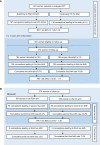Long-term outcomes of switching to gonadotrophins versus continuing with clomiphene citrate, with or without intrauterine insemination, in women with normogonadotropic anovulation and clomiphene failure: follow-up study of a factorial randomized clinical trial
- PMID: 36622200
- PMCID: PMC9977112
- DOI: 10.1093/humrep/deac268
Long-term outcomes of switching to gonadotrophins versus continuing with clomiphene citrate, with or without intrauterine insemination, in women with normogonadotropic anovulation and clomiphene failure: follow-up study of a factorial randomized clinical trial
Abstract
Study question: What are the long-term outcomes after allocation to use of gonadotrophins versus clomiphene citrate (CC) with or without IUI in women with normogonadotropic anovulation and clomiphene failure?
Summary answer: About four in five women with normogonadotropic anovulation and CC failure had a live birth, with no evidence of a difference in pregnancy outcomes between the allocated groups.
What is known already: CC has long been used as first line treatment for ovulation induction in women with normogonadotropic anovulation. Between 2009 and 2015, a two-by-two factorial multicentre randomized clinical trial in 666 women with normogonadotropic anovulation and six cycles of CC failure was performed (M-ovin trial). This study compared a switch to gonadotrophins with continued treatment with CC for another six cycles, with or without IUI within 8 months. Switching to gonadotrophins increased the chance of conception leading to live birth by 11% over continued treatment with CC after six failed ovulatory cycles, at a cost of €15 258 per additional live birth. The addition of IUI did not significantly increase live birth rates.
Study design, size, duration: In order to investigate the long-term outcomes of switching to gonadotrophins versus continuing treatment with CC, and undergoing IUI versus continuing with intercourse, we conducted a follow-up study. The study population comprised all women who participated in the M-ovin trial.
Participants/materials, setting, methods: The participating women were asked to complete a web-based questionnaire. The primary outcome of this study was cumulative live birth. Secondary outcomes included clinical pregnancies, multiple pregnancies, miscarriage, stillbirth, ectopic pregnancy, fertility treatments, neonatal outcomes and pregnancy complications.
Main results and the role of chance: We approached 564 women (85%), of whom 374 (66%) responded (184 allocated to gonadotrophins; 190 to CC). After a median follow-up time of 8 years, 154 women in the gonadotrophin group had a live birth (83.7%) versus 150 women in the CC group (78.9%) (relative risk (RR) 1.06, 95% CI 0.96-1.17). A second live birth occurred in 85 of 184 women (49.0%) in the gonadotrophin group and in 85 of 190 women (44.7%) in the CC group (RR 1.03, 95% CI 0.83-1.29). Women allocated to gonadotrophins had a third live birth in 6 of 184 women (3.3%) and women allocated to CC had a third live birth in 14 of 190 women (7.4%). There were respectively 12 and 11 twins in the gonadotrophin and CC groups. The use of fertility treatments in the follow-up period was comparable between both groups. In the IUI group, a first live birth occurred in 158 of 192 women (82.3%) and while in the intercourse group, 146 of 182 women (80.2%) reached at least one live birth (RR: 1.03 95% CI 0.93-1.13; 2.13%, 95% CI -5.95, 10.21).
Limitations, reasons for caution: We have complete follow-up results for 57% of the women.There were 185 women who did not respond to the questionnaire, while 102 women had not been approached due to missing contact details. Five women had not started the original trial.
Wider implications of the findings: Women with normogonadotropic anovulation and CC failure have a high chance of reaching at least one live birth. In terms of pregnancy rates, the long-term differences between initially switching to gonadotrophins are small compared to continuing treatment with CC.
Study funding/competing interest(s): The original study received funding from the Dutch Organization for Health Research and Development (ZonMw number: 80-82310-97-12067). A.H. reports consultancy for development and implementation of a lifestyle App, MyFertiCoach, developed by Ferring Pharmaceutical Company. M.G. receives unrestricted grants for scientific research and education from Ferring, Merck and Guerbet. B.W.M. is supported by an NHMRC Investigatorgrant (GNT1176437). B.W.M. reports consultancy for ObsEva and Merck and travel support from Merck. All other authors have nothing to declare.
Trial registration number: This follow-up study was registered in the OSF Register, https://osf.io/pf24m. The original M-ovin trial was registered in the Netherlands Trial Register, number NTR1449.
Keywords: PCOS; clomiphene citrate; cumulative live birth; gonadotrophins; ovulation induction.
© The Author(s) 2023. Published by Oxford University Press on behalf of European Society of Human Reproduction and Embryology.
Figures


References
-
- Bordewijk EM, Weiss NS, Nahuis MJ, Bayram N, van Hooff MHA, Boks DES, Perquin DAM, Janssen CAH, van Golde RJT, Lambalk CB. et al.; M-ovin study group. Gonadotrophins versus clomiphene citrate with or without IUI in women with normogonadotropic anovulation and clomiphene failure: a cost-effectiveness analysis. Hum Reprod 2019;34:276–284. - PubMed
-
- Bordewijk EM, Weiss NS, Nahuis MJ, Kwee J, Lambeek AF, van Unnik GA, Vrouenraets FP J, Cohlen BJ, van de Laar-van Asseldonk TAM, Lambalk CB. et al.; M-ovin study group. Gonadotrophins or clomiphene citrate in women with normogonadotropic anovulation and CC failure: does the endometrium matter? Hum Reprod 2020;35:1319–1324. - PMC - PubMed
-
- Duffy JMN, AlAhwany H, Bhattacharya S, Collura B, Curtis C, Evers JLH, Farquharson RG, Franik S, Giudice LC, Khalaf Y. et al.; Core Outcome Measure for Infertility Trials (COMMIT) initiative. Developing a core outcome set for future infertility research: an international consensus development study. Hum Reprod 2020;35:2725–2734. - PMC - PubMed
Publication types
MeSH terms
Substances
Associated data
LinkOut - more resources
Full Text Sources
Research Materials

